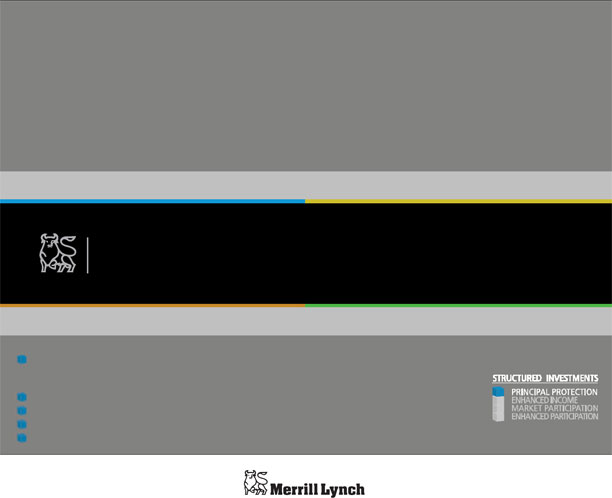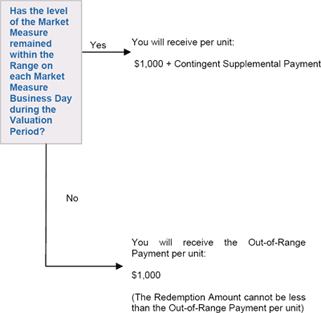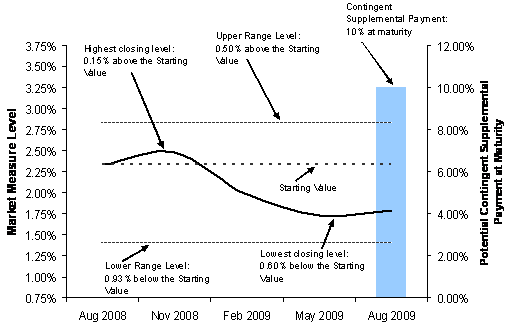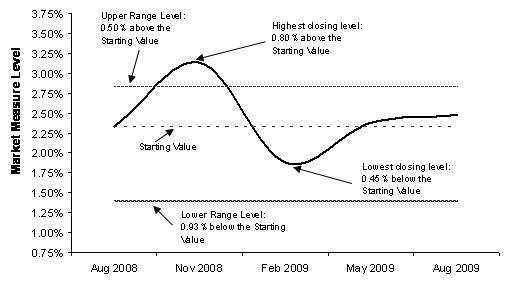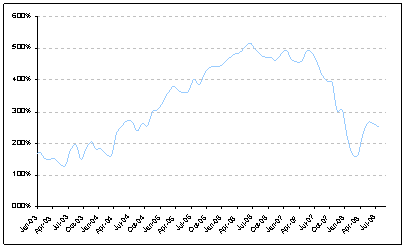
100% Principal Protected Range Notes
Linked to the 2-Year Constant Maturity Treasury Rate due October , 2009
Certain U.S. Federal Income Taxation Considerations
Set forth below is a summary of certain United States federal income tax considerations relating to an investment in the Notes. The following summary is not complete and is qualified in its entirety by the discussion under the section entitled “United States Federal Income Taxation” in the accompanying product supplement RN-1 and MTN prospectus supplement, which you should carefully review prior to investing in the Notes.
Capitalized terms used and not defined herein have the meanings ascribed to them in the accompanying product supplement RN-1.
Characterization of the Notes. There are no statutory provisions, regulations, published rulings or judicial decisions addressing or involving the characterization, for United States federal income tax purposes, of the Notes or securities with terms substantially the same as the Notes. However, although the matter is not free from doubt, under current law, each Note should be treated as a debt instrument of
ML&Co. for United States federal income tax purposes. ML&Co. currently intends to treat each Note as a debt instrument of ML&Co. for United States federal income tax purposes and, where required, intends to file information returns with the Internal Revenue Service (the “IRS”) in accordance with this treatment, in the absence of any change or clarification in the law, by regulation or otherwise, requiring a different characterization of the Notes. Prospective
investors in the Notes should be aware, however, that the IRS is not bound by ML&Co.’s characterization of the Notes as indebtedness, and the IRS could possibly take a different position as to the proper characterization of the Notes for United States federal income tax purposes. Accordingly, prospective purchasers are urged to consult their own tax advisors regarding the tax consequences of investing in the Notes. The following summary assumes that the Notes will be treated
as debt instruments of ML&Co. for United States federal income tax purposes.
General.The Notes will be treated as contingent payment debt instruments. On June 11, 1996, the Treasury Department issued final regulations (the “CPDI Regulations”) concerning the proper United States federal income tax treatment of contingent payment debt instruments such as the Notes, which apply to debt instruments issued on or after August 13, 1996 and, accordingly, will apply to the Notes. In
general, the CPDI Regulations cause the timing and character of income, gain or loss reported on a contingent payment debt instrument to substantially differ from the timing and character of income, gain or loss reported on a conventional noncontingent payment debt instrument. Specifically, the CPDI Regulations generally require a U.S. Holder of such an instrument to include future contingent and noncontingent interest payments in income as that interest accrues based upon a projected
payment schedule. Moreover, in general, under the CPDI Regulations, any gain recognized by a U.S. Holder on the sale, exchange, or other disposition of a contingent payment debt instrument is treated as ordinary income, and all or a portion of any loss realized could be treated as ordinary loss as opposed to capital loss (depending upon the circumstances). The CPDI Regulations provide no definitive guidance as to whether or not an instrument is properly characterized as a debt
instrument for United States federal income tax purposes.
Interest Accruals. Each year, a U.S. Holder of a Note generally will be required to pay taxes on ordinary income from such Note over its term based upon an estimated yield for the Note, even though such U.S. Holder will not receive any payments until the maturity date. ML&Co. will have established this estimated yield, in accordance with the CPDI Regulations, solely in order for a U.S. Holder to calculate the
amount of taxes that such U.S. Holder will owe each year as a result of owning a Note. This estimated yield will not be either a prediction or a guarantee of what the actual Redemption Amount will be, or that the actual Redemption Amount will even exceed the Original Public Offering Price.
In particular, solely for purposes of applying the CPDI Regulations to the Notes, ML&Co. will be required to construct a projected payment schedule for the Notes which will consist of a projected cash payment on the maturity date of an amount equal to an estimate of the Redemption Amount per unit of the Notes (the “Projected Redemption Amount”). This projected payment schedule will represent an estimated yield on the Notes.
Accordingly, during the term of the Notes, a U.S. Holder of a Note will be required to include in income as ordinary interest an amount equal to the sum of the daily portions of interest on the Note that are deemed to accrue at this estimated yield for each day during the taxable year (or portion of the taxable year) on which the U.S. Holder holds the Note. The amount of interest that will be deemed to accrue in any accrual period (i.e., generally each six-month period during which the
Notes are outstanding) will equal the product of this estimated yield (properly adjusted for the length of the accrual period) and the Note’s adjusted issue price (as defined below) at the beginning of the accrual period. The daily portions of interest will be determined by allocating to each day in the accrual period the ratable portion of the interest that is deemed to accrue during the accrual period. In general, for these purposes a Note’s adjusted issue price will equal
the Note’s issue price (i.e., the Original Public Offering Price of a Note), increased by the interest previously accrued on the Note. On the maturity date of a Note, in the event that the actual cash payment on the maturity date (the “Actual Redemption Amount”) exceeds the Projected Redemption Amount, a U.S. Holder will be required to include the excess of the Actual Redemption Amount over the Projected Redemption Amount in income as ordinary interest on the maturity
date. Alternatively, in the event that the Actual Redemption Amount is less than the Projected Redemption Amount, the amount by which the Projected Redemption Amount exceeds the Actual Redemption Amount will be treated first as an offset to any interest otherwise includible in income by the U.S. Holder with respect to the Note for the taxable year in which the maturity date occurs to the extent of the amount of that includible interest. Further, a U.S. Holder will be permitted to
recognize and deduct, as an ordinary loss that is not subject to the limitations applicable to miscellaneous itemized deductions, any remaining portion of the Projected Redemption Amount in excess of the Actual Redemption Amount that is not treated as an interest offset pursuant to the foregoing rules. In addition, U.S. Holders purchasing a Note at a price that differs from the adjusted issue price of the Note as of the purchase date (e.g., subsequent purchasers) will be subject to
rules providing for certain adjustment to the foregoing rules and these U.S. Holders should consult their own tax advisors concerning these rules.
Notwithstanding the foregoing, special rules will apply if a contingent payment on a Note becomes fixed more than six months prior to its scheduled date of payment. For this purpose, a payment will be treated as fixed if (and when) all remaining contingencies with respect to it are remote or incidental, within the meaning of the CPDI Regulations. Thus, if the rate of the Market Measure is outside the Range during the Valuation Period, these
special rules could possibly apply to the Notes. Generally, in such a case, a U.S. Holder would be required to account for the difference between the present value of the fixed amount of the contingent payment and the present value of the amount of the projected payment in a reasonable manner over the remaining term of the Note. A U.S. Holder’s tax basis in a Note and the character of any gain or loss on the sale of the Note could also be affected. U.S. Holders should consult
their own tax advisors concerning these special rules.
Sale or Exchange of the Notes. Upon the sale, exchange or other disposition of a Note prior to the maturity date, a U.S. Holder will be required to recognize taxable gain or loss in an amount equal to the difference, if any, between the amount realized by the U.S. Holder upon such sale, exchange or other disposition and the U.S. Holder’s adjusted tax basis in the Note as of the date of disposition. A U.S.
Holder’s adjusted tax basis in a Note generally will equal the U.S. Holder’s initial investment in the Note increased by any interest previously included in income with respect to the Note by the U.S. Holder. Any taxable gain will be treated as ordinary income. Any taxable loss will be treated as ordinary loss to the extent of the U.S. Holder’s total interest inclusions on the Note. Any remaining loss generally will be treated as long-term or short-term capital loss
(depending upon the U.S. Holder’s holding period for the Note). All amounts includible in income by a U.S. Holder as ordinary interest pursuant to the CPDI Regulations will be treated as original issue discount. In addition, U.S. Holders purchasing a Note at a price that differs from the adjusted issue price of the Note as of the purchase date (e.g., subsequent purchasers) will be subject to rules providing for certain adjustments to the foregoing rules and these U.S. Holders
should consult their own tax advisors concerning these rules.
Hypothetical Table. The following table sets forth the amount of interest that would be deemed to have accrued with respect to each Note during each accrual period over an assumed term of one year and a day for the Notes based upon a hypothetical projected payment schedule for the Notes (including both a hypothetical Projected Redemption Amount and a hypothetical estimated yield equal to 4.9625% per annum
(compounded semi-annually)) as determined by ML&Co. for purposes of
illustrating the application of the CPDI Regulations to the Notes as if they had
been issued on August 25, 2008, and were scheduled to mature on August 26, 2009.
The following table is for illustrative purposes only. The actual projected
TS-10


100% Principal Protected Range Notes
Linked to the 2-Year Constant Maturity Treasury Rate due October , 2009
payment schedule for any Notes (including both the actual Projected Redemption
Amount and the actual estimated yield) will be determined by ML&Co. on the
Pricing Date and will depend upon actual market interest rates (and thus
ML&Co.’s borrowing costs for debt instruments with comparable
maturities) as of that date. The actual projected payment schedule for the Notes
(including both the actual Projected Redemption Amount and the actual estimated
yield) and the actual tax accrual table will be set forth in the final Term
Sheet delivered to investors in connection with the initial sale of such
Notes.
|
|
|
|
|
|
|
|
Hypothetical Accrual Period
|
|
Interest deemed to
accrue on the Notes
during accrual
period (per unit of
the Notes)
|
|
Total interest deemed
to have accrued the
Notes as of end of
accrual period (per unit
of the Notes)
|
|
|
|
|
|
|
|
|
August 25, 2008 through February 26, 2009
|
|
$0.2516
|
|
$0.2516
|
|
|
February 27, 2009 through August 26, 2009
|
|
$0.2543
|
|
$0.5059
|
|
Hypothetical Projected Redemption Amount = $10.5059 per unit of the Notes.
Prospective purchasers of the Notes should consult their own tax advisors concerning the tax consequences, in light of their particular circumstances, under the laws of the United States and any other taxing jurisdiction, of the purchase, ownership and disposition of the Notes. See the discussion under the section entitled “United States Federal Income Taxation” in the accompanying product supplement RN-1.
TS-11


100% Principal Protected Range Notes
Linked to the 2-Year Constant Maturity Treasury Rate due October , 2009
Additional Note Terms
You should read this term sheet, together with the documents listed below (collectively, the “Note Prospectus”), which together contain the terms of the Notes and supersede all prior or contemporaneous oral statements as well as any other written materials. You should carefully consider, among other things, the matters set forth under “Risk Factors” in the sections indicated on the cover of this term sheet. The Notes involve risks
not associated with conventional debt securities. We urge you to consult your investment, legal, tax, accounting and other advisers before you invest in the Notes.
You may access the following documents on the SEC Website at www.sec.gov as follows (or if such address has changed, by reviewing our filings for the relevant date on the SEC Website):
|
|
|
|
|
|
§
|
Product supplement RN-1 dated August 27, 2008:
|
|
|
|
http://sec.gov/Archives/edgar/data/65100/000119312508185691/d424b2.htm
|
|
|
|
|
|
|
§
|
MTN prospectus supplement dated March 31, 2006:
|
|
|
|
http://www.sec.gov/Archives/edgar/data/65100/000119312506070946/d424b5.htm
|
|
|
|
|
|
|
§
|
General prospectus supplement dated March 31, 2006:
|
|
|
|
http://www.sec.gov/Archives/edgar/data/65100/000119312506070973/d424b5.htm
|
|
|
|
|
|
|
§
|
Prospectus dated March 31, 2006:
|
|
|
|
http://www.sec.gov/Archives/edgar/data/65100/000119312506070817/ds3asr.htm
|
Our Central Index Key, or CIK, on the SEC Website is 65100. References in this term sheet to “ML&Co.”, “we”, “us” and “our” are to Merrill Lynch & Co., Inc., and references to “MLPF&S” are to Merrill Lynch, Pierce, Fenner & Smith Incorporated.
We have filed a registration statement (including a prospectus) with the Securities and Exchange Commission (the “SEC”) for the offering to which this term sheet relates. Before you invest, you should read the prospectus in that registration statement, and the other documents relating to this offering that we have filed with the SEC for more complete information about us and this offering. You may get these documents without
cost by visiting EDGAR on the SEC Website at www.sec.gov. Alternatively, we, any agent or any dealer participating in this offering, will arrange to send you the Notes Prospectus if you so request by calling toll-free 1-866-500-5408.
Structured Investments Classification
ML&Co. classifies certain of its structured investments (the “Structured Investments”), including the Notes, into four categories, each with different investment characteristics. The description below is intended to briefly describe the four categories of Structured Investments offered: Principal Protection, Enhanced Income, Market Participation and Enhanced Participation. A Structured Investment may, however, combine
characteristics that are relevant to one or more of the other categories. As such, a category should not be relied upon as a description of any particular Structured Investment.
Principal Protection: Principal Protected Structured Investments offer full or partial principal protection at maturity, while offering market exposure and the opportunity for a better return than may be available from comparable fixed income securities. Principal protection may not be achieved if the investment is sold prior to maturity.
Enhanced Income: Structured Investments offering enhanced income may offer an enhanced income stream through interim fixed or variable coupon payments. However, in exchange for receiving current income, investors may forfeit upside potential on the underlying asset. These investments generally do not include the principal protection feature.
Market Participation: Market Participation Structured Investments can offer investors exposure to specific market sectors, asset classes and/or strategies that may not be readily available through traditional investment alternatives. Returns obtained from these investments are tied to the performance of the underlying asset. As such, subject to certain fees, the returns will generally reflect any increases
or decreases in the value of such assets. These investments are not structured to include the principal protection feature.
Enhanced Participation: Enhanced Participation Structured Investments may offer investors the potential to receive better than market returns on the performance of the underlying asset. Some structures may offer leverage in exchange for a capped or limited upside potential and also in exchange for downside risk. These investments are not structured to include the principal protection
feature.
The classification of Structured Investments is meant solely for informational purposes and is not intended to fully describe any particular Structured Investment nor guarantee any particular performance.
TS-12
